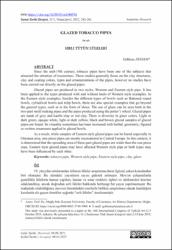GLAZED TOBACCO PIPES
Citation
Ayhan, G. (2022). Glazed Tobacco Pipes . Sanat Tarihi Dergisi , 31 (1) , 243-261 . DOI: 10.29135/std.980754Abstract
Since the mid-19th century, tobacco pipes have been one of the subjects that attracted the attention of researchers. These studies generally focus on the clay structures, clay and coating colors, types and ornamentations of the pipes, however no studies have been carried out directly on the glazed pipes.
Glazed pipes are produced in two styles, Western and Eastern style pipe. It has been applied to the types produced with and without heels of Western style examples. In the Eastern style examples, besides the different types of bowls such as flattened round bowls, cylindrical bowls and tulip bowls, there are also special examples that go beyond the general types, such as in the form of shoes. The use of glaze can be seen both in the two-part mold making pipes and the pipes produced using the potter's wheel. Glazed pipes are made of grey and kaolin clay or red clay. There is diversity in glaze colors. Light or dark green, opaque white, light or dark yellow, black and brown glazed samples of glazed pipes are found. Its visuality sometimes has been increased with herbal, geometric, figured or written ornaments applied to glazed bowls.
As a result, while samples of Eastern style glazed pipes can be found especially in Ottoman area; one-piece pipes are mostly encountered in Central Europe. In this context, it is determined that the spreading area of three-part glazed pipes are wider than the one-piece ones. Eastern style glazed pipes may have affected Western style pipe or both types may have been influenced by each other.


















